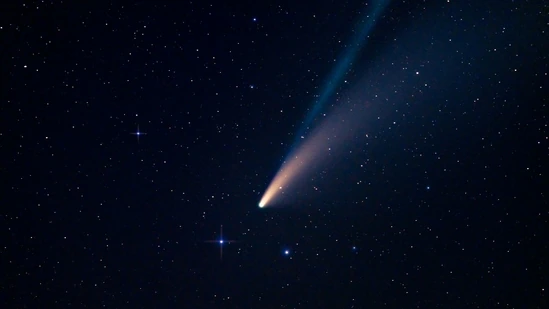The famed Halley’s Comet is currently about halfway through its roughly 76-year orbit around the sun, having reached its furthest point from the star in December 2023. Although this historic comet won’t be visible in the night sky again until 2061, it is leaving behind a trail of debris that creates the annual Orionid meteor shower. This celestial event will peak this Sunday night into Monday, with skywatchers anticipating the sight of 10 to 20 meteors streaking across the sky each hour, as reported by the American Meteor Society.
According to Robert Lunsford, the fireball report coordinator for the American Meteor Society, the optimal time to view the Orionids will be after midnight when the constellation Orion—the radiant point from which the meteors appear to emanate—is high in the night sky. The display can be seen worldwide, except in Antarctica, where continuous daylight currently prevails.

What makes the Orionids particularly exciting is their “flat peak” of activity, meaning that even a few days after the main event, the meteor shower will still produce a significant number of visible meteors. “If it’s cloudy on the peak night, the night after should be very close to the same activity you would see before,” Lunsford explained, encouraging those interested in observing the meteor shower not to be discouraged by less-than-ideal conditions.
Later in October, the celestial phenomenon will benefit from the waning light of the Hunter’s Moon, which reached its full phase on Thursday. The moon’s diminishing brightness should reduce its interference with meteor viewing. Lunsford advises skywatchers to position themselves opposite the moon when observing to mitigate the impact of its light on the visibility of fainter meteors. The Orionids will remain active until November 22, offering plenty of opportunities to catch a glimpse of these shooting stars.
As Earth orbits the sun, it intersects with the debris trail left by Halley’s Comet twice a year. The first encounter occurs in May, resulting in the annual Eta Aquariid meteor shower, while the second occurs in October, creating the Orionids. When these comet particles enter the Earth’s atmosphere, they ignite and produce the brilliant meteors that captivate skywatchers. Larger particles can even generate fireballs, which are exceptionally bright meteors that can outshine Venus, as noted by NASA.

In contrast, particles originating from asteroids can occasionally survive their journey through the atmosphere, landing on Earth as meteorites. However, the icy composition of comets makes them less likely to survive this intense passage. “Typically, comets are too fragile to withstand the journey through Earth’s atmosphere,” Lunsford explained, emphasizing the difference between the materials found in asteroids and those found in comets.
For those eager to catch a glimpse of the Orionids, NASA recommends spending at least 30 minutes outdoors before viewing to allow your eyes to adjust to the dark. Finding a high-altitude location can also improve visibility, as clearer skies and less moonlight will enhance the experience. “The best part of viewing a meteor shower is getting in touch with nature and being part of the universe,” Lunsford said, highlighting the unique experience of witnessing celestial movement.
If you missed the recent Comet C/2023 A3 Tsuchinshan-ATLAS during its closest approach to Earth on October 12, there is still time to see it. NASA predicts that the comet will remain visible until early November. Skywatchers should look to the western part of the night sky shortly after sunset for a chance to view this extraordinary celestial phenomenon.
Originally believed to take about 80,000 years to complete its orbit, Comet C/2023 A3 has been observed to have a new trajectory that may remove it from our solar system entirely. As the year draws to a close, two significant full moons remain in 2024: the Beaver Moon, which is also a supermoon, on November 15, and the Cold Moon on December 15, as noted by the Farmers’ Almanac.

Looking ahead, skywatchers can look forward to an active season of meteor showers to wrap up 2024. Notable upcoming celestial events include the Southern Taurids on November 4-5, the Northern Taurids on November 11-12, the Leonids on November 17-18, the Geminids on December 13-14, and the Ursids on December 21-22, according to the American Meteor Society. With so many opportunities to witness spectacular meteor displays, the fall and winter months promise to be an exciting time for astronomy enthusiasts and casual observers alike.




